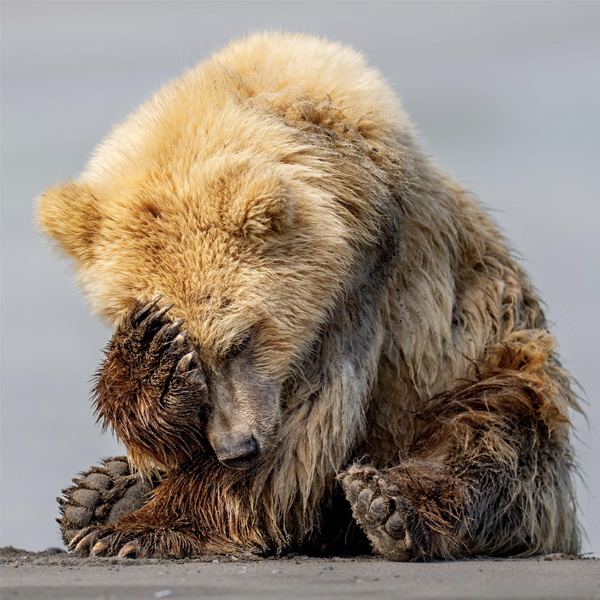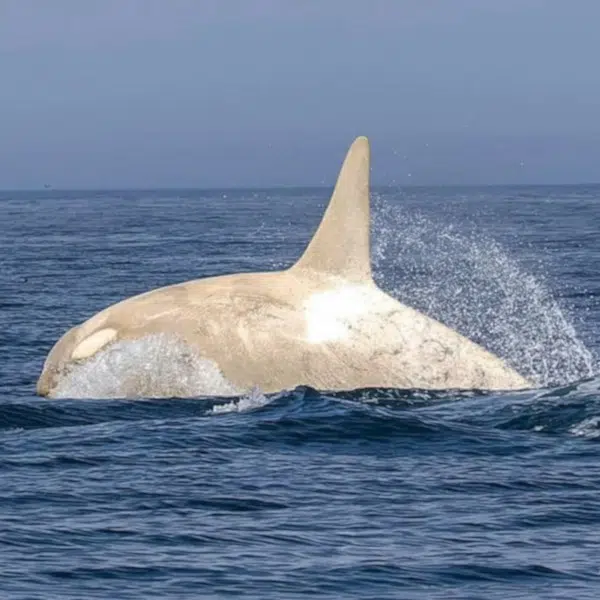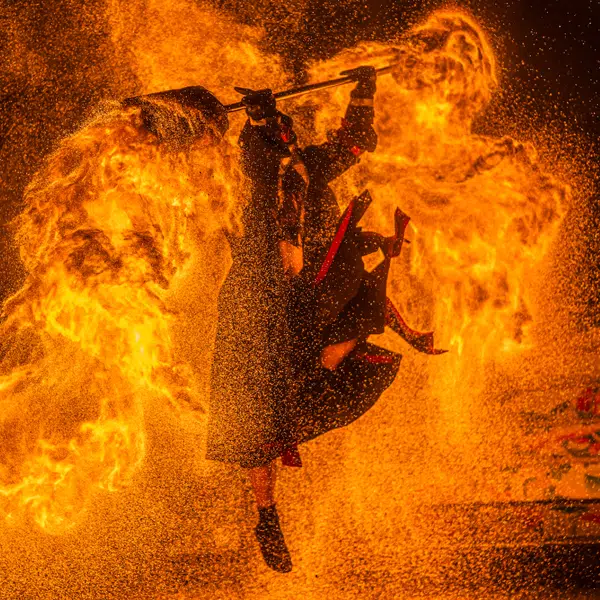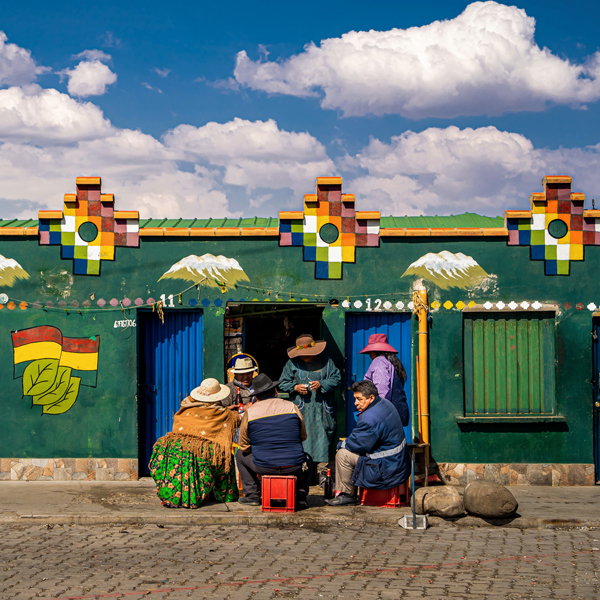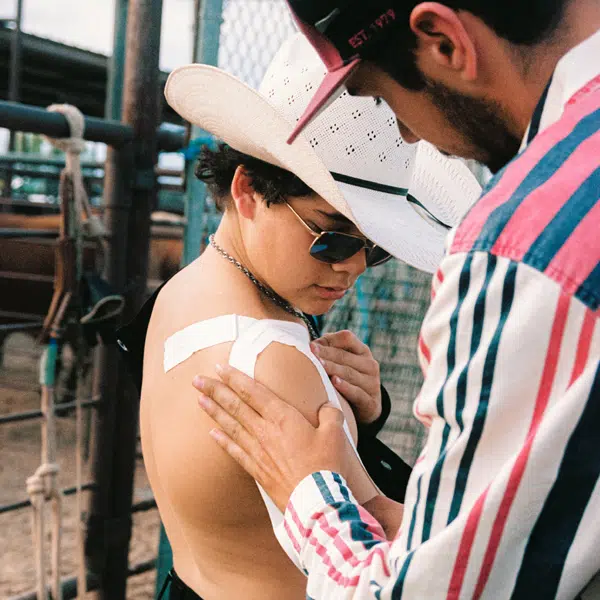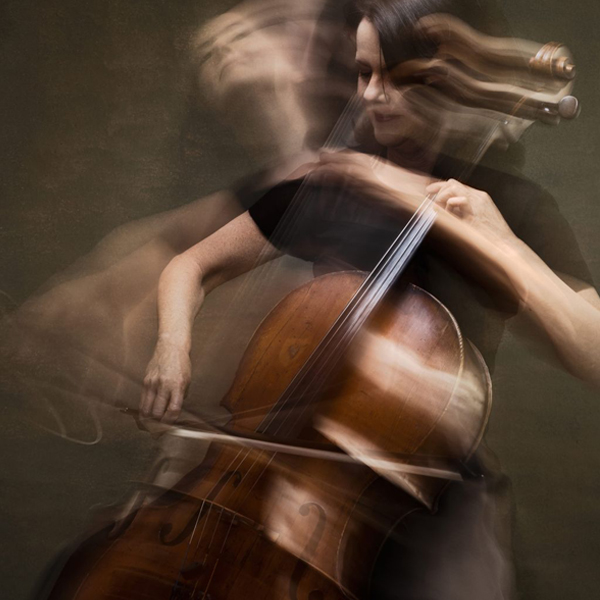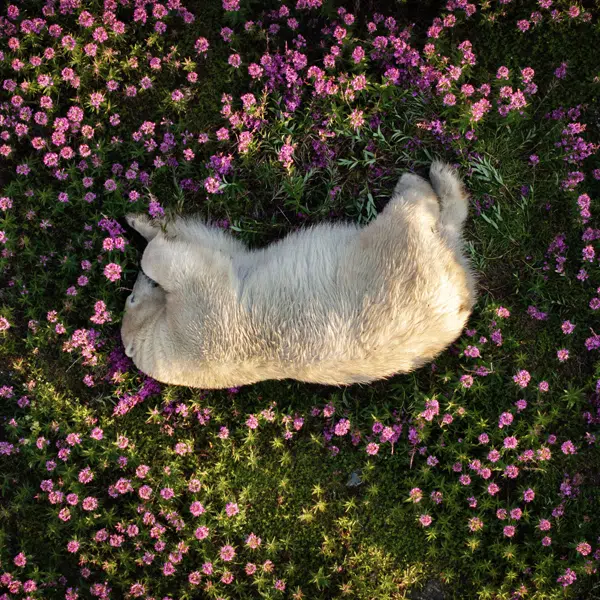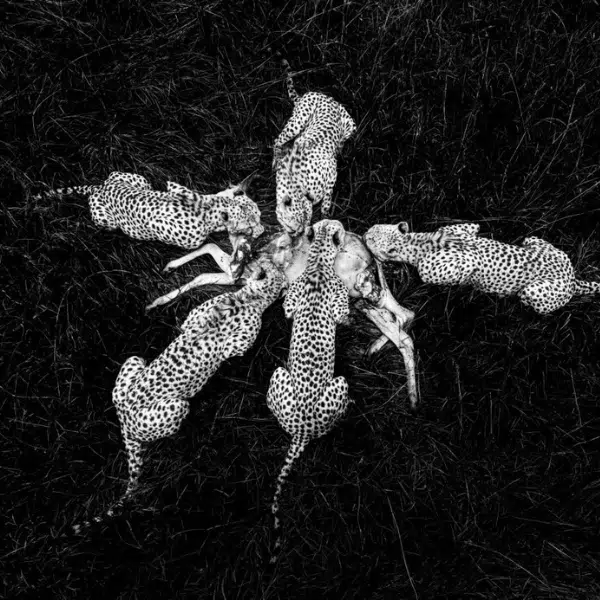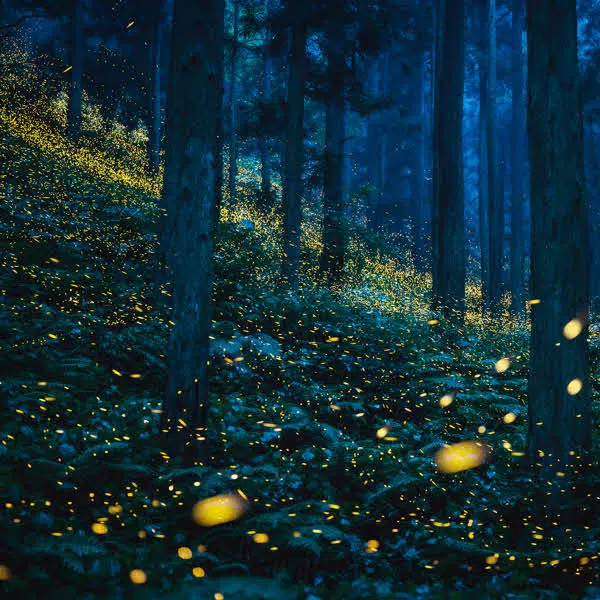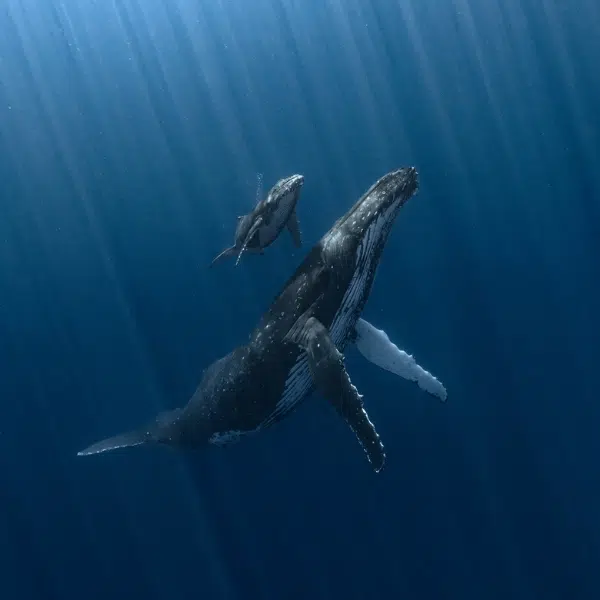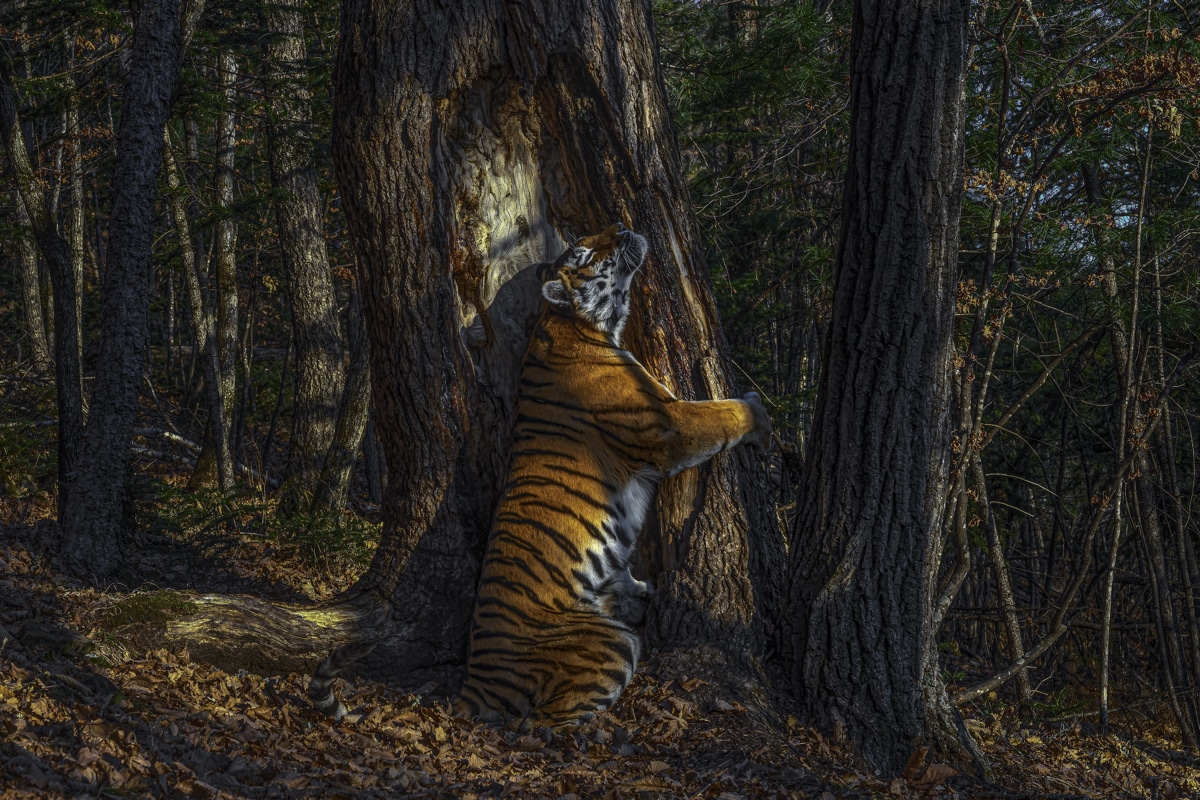
“The embrace” by Sergey Gorshkov (Russia). Winner, Wildlife Photographer of the Year & Winner, Animals in their Environment.
“With an expression of sheer ecstasy, a tigress hugs an ancient Manchurian fir, rubbing her cheek against bark to leave secretions from her scent glands. She is an Amur, or Siberian, tiger, here in the Land of the Leopard National Park, in the Russian Far East. The race – now regarded as the same subspecies as the Bengal tiger – is found only in this region, with a small number surviving over the border in China and possibly a few in North Korea. Hunted almost to extinction in the past century, the population is still threatened by poaching and logging, which also impacts their prey – mostly deer and wild boar, which are also hunted. But recent (unpublished) camera‑trap surveys indicate that greater protection may have resulted in a population of possibly 500–600 – an increase that it is hoped a future formal census may confirm. Low prey densities mean that tiger territories are huge. Sergey knew his chances were slim but he was determined to take a picture of the totem animal of his Siberian homeland. Scouring the forest for signs, focusing on trees along regular routes where tigers might have left messages – scent, hairs, urine, or scratch marks – he installed his first proper camera trap in January 2019, opposite this grand fir. But it was not until November that he achieved the picture he had planned for, of a magnificent tigress in her Siberian forest environment.”
Over 49,000 submissions flooded into the Natural History Museum London's Wildlife Photographer of the Year 2020 competition. This year, the winners were revealed during a special online ceremony. The Duchess of Cambridge, Kate Middleton, made the announcement that Russian photographer Sergey Gorshkov won the top prize for his photo of a Siberian tiger.
The photograph, taken with a hidden camera, shows a female tigress rubbing her cheek against a Manchurian fir in a national park in far-east Russia. This incredible species can only be found there after being nearly hunted to extinction. By marking the tree, the tigress is leaving behind her scent for others to discover. Gorshkov's win is a fitting prize for his patience, as he set the camera trap a full 11 months before he got this picture.
“It’s a scene like no other,” says judging panel chair Rosamund Kid Cox. “A unique glimpse of an intimate moment deep in a magical forest. Shafts of low winter sun highlight the ancient fir tree and the coat of the huge tigress as she grips the trunk in obvious ecstasy and inhales the scent of tiger on resin, leaving her own mark as her message. It’s also a story told in glorious color and texture of the comeback of the Amur tiger, a symbol of the Russian wilderness.”
Another grand prize winner showed skill well beyond her years. Liina Heikkinen won the 15- to 17-year-old category, as well as the title of Young Wildlife Photographer of the Year, for her magnificent shot of a young fox ensuring that its siblings won't have any of the goose it had caught.
“A sense of furtive drama and frantic urgency enlivens this image, drawing us into the frame,” says jury member, Shekar Dattatri. “The sharp focus on the fox’s face leads us straight to where the action is. A great natural history moment captured perfectly.”
Starting on October 16, the Wildlife Photographer of the Year exhibition at the Natural History Museum will be open to the public before beginning its tour. To ensure safety, crowds will be limited and tickets must be booked in advance. Check out more winners below and, if you want to try your hand at next year's competition, entries open on October 19, 2020.
Dive into more incredible winning photos from the 2020 Wildlife Photographer of the Year competition.
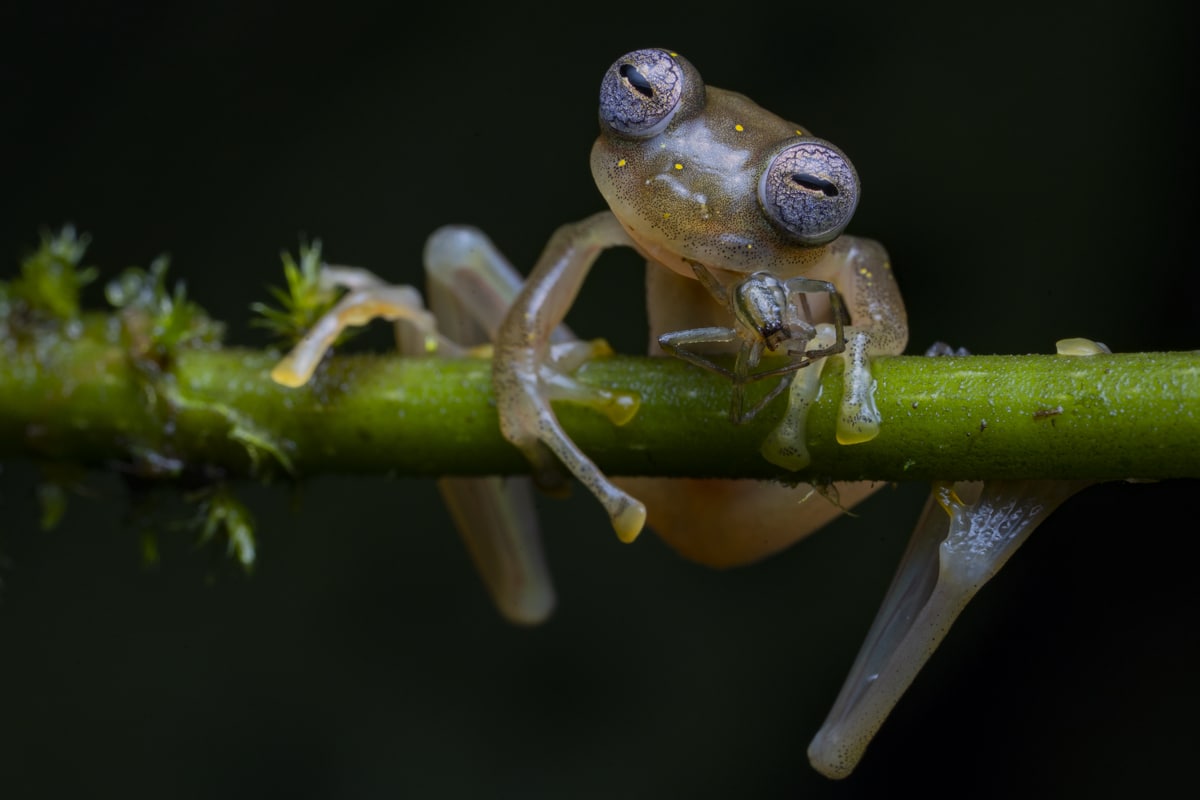
“Life in the balance” by Jaime Culebras (Spain). Winner, Behavior: Amphibians, and Reptiles.
“A Manduriacu glass frog snacks on a spider in the foothills of the Andes, northwestern Ecuador. As big consumers of invertebrates, glass frogs play a key part in maintaining balanced ecosystems. That night, Jaime’s determination to share his passion for them had driven him to walk for four hours, in heavy rain, through the forest to reach the frogs’ streams in Manduriacu Reserve. But the frogs were elusive and the downpour was growing heavier and heavier. As he turned back, he was thrilled to spot one small frog clinging to a branch, its eyes like shimmering mosaics. Not only was it eating – he had photographed glass frogs eating only once before – but it was also a newly discovered species. Distinguished by the yellow spots on its back and lack of webbing between its fingers, the Manduriacu frog is found only in this small area. The reserve is private but seriously threatened by mining activities permitted by the government (open-pit mining for gold and copper), as well as illegal logging, and the new frog is considered critically endangered. Serenaded by a frog chorus in torrential rain – he held his umbrella and flash in one hand and the camera in the other – Jaime captured the first ever picture of this species feeding.”
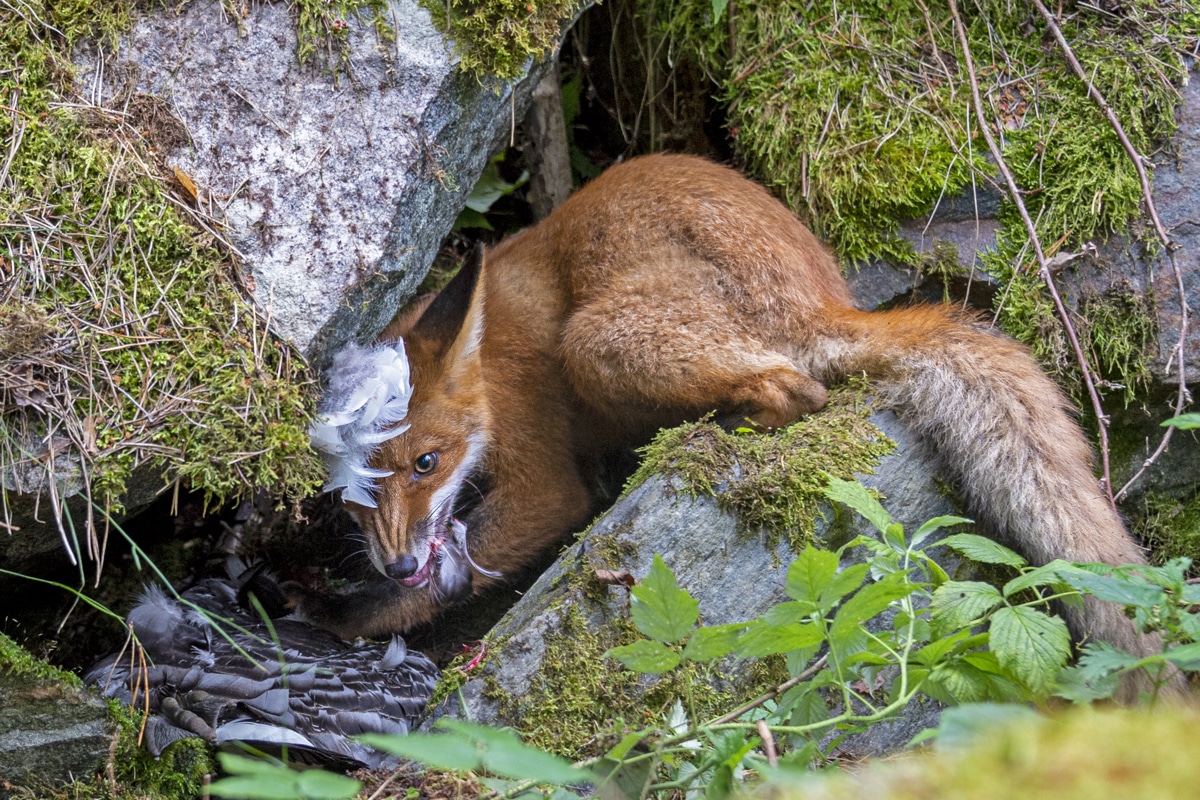
“The fox that got the goose” by Liina Heikkinen (Finland). Winner, 15-17 years old, Young Wildlife Photographer of the Year.
“It was on a summer holiday in Helsinki that Liina, then aged 13, heard about a large fox family living in the city suburbs on the island of Lehtisaari. The island has both wooded areas and fox-friendly citizens, and the foxes are relatively unafraid of humans. So Liina and her father spent one long July day, without a hide, watching the two adults and their six large cubs, which were almost the size of their parents, though slimmer and lankier. In another month, the cubs would be able to fend for themselves, but in July they were only catching insects and earthworms and a few rodents, and the parents were still bringing food for them – larger prey than the more normal voles and mice. It was 7 pm when the excitement began, with the vixen’s arrival with a barnacle goose. Feathers flew as the cubs began fighting over it. One finally gained ownership – urinating on it in its excitement. Dragging the goose into a crevice, the cub attempted to eat its prize while blocking access to the others. Lying just meters away, Liina was able to frame the scene and capture the expression of the youngster as it attempted to keep its hungry siblings at bay.”

“The pose” by Mogens Trolle (Denmark). Winner, Animal Portraits.
“A young male proboscis monkey cocks his head slightly and closes his eyes. Unexpected pale blue eyelids now complement his immaculately groomed auburn hair. He poses for a few seconds as if in meditation. He is a wild visitor to the feeding station at Labuk Bay Proboscis Monkey Sanctuary in Sabah, Borneo – ‘the most laid-back character,’ says Mogens, who has been photographing primates worldwide for the past five years. In some primate species, contrasting eyelids play a role in social communication, but their function in proboscis monkeys is uncertain. The most distinctive aspect of this young male – sitting apart from his bachelor group – is, of course, his nose. As he matures, it will signal his status and mood (female noses are much smaller) and be used as a resonator when calling. Indeed, it will grow so big that it will hang down over his mouth – he may even need to push it aside to eat. Found only on the island of Borneo and nearby islands, proboscis monkeys are endangered. Eating mainly leaves (along with flowers, seeds and unripe fruit), they depend on threatened forests close to waterways or the coast and – being relatively lethargic – are easily hunted for food and bezoar stones (an intestinal secretion used in traditional Chinese medicine). Mogens’ unforgettable portrait, with the young male’s characteristic peaceful expression – ‘quite unlike anything I’ve ever seen on another monkey’ – connects us, he hopes, with a fellow primate.”

“When mother says run” by Shanyuan Li (China). Winner, Behavior: Mammals.
“This rare picture of a family of Pallas’s cats, or manuls, on the remote steppes of the Qinghai–Tibet Plateau in northwest China is the result of six years’ work at high altitude. These small cats are normally solitary, hard to find, and mostly active at dawn and dusk. Through long-term observation, Shanyuan knew his best chance to photograph them in daylight would be in August and September when the kittens were a few months old and the mothers bolder and intent on caring for them. He tracked the family as they descended to about 3,800 meters (12,500 feet) in search of their favorite food – pikas (small, rabbit‑like mammals) – and set up his hide on the hill opposite their lair, an old marmot hole. Hours of patience were rewarded when the three kittens came out to play, while their mother kept her eye on a Tibetan fox lurking nearby. Their broad, flat heads, with small, low‑set ears, together with their color and markings, help them stay hidden when hunting in open country, and their thick coats keep them alive in the extreme winters. In the clear air, against a soft background, Shanyuan caught their expressions in a rarely seen moment of family life, when their mother had issued a warning to hurry back to the safety of the lair. Their real threat, though, is not foxes but the degradation and fragmentation of their steppe grassland – throughout their Central Asian range – caused by overgrazing, arable conversion, mining, and general human disturbance, alongside poisoning of their prey and hunting, for their fur and as pets.”

“Backroom business” by Paul Hilton (UK/Australia). Winner, Wildlife Photojournalist Story Award.
“A young pig-tailed macaque is put on show chained to a wooden cage in Bali’s bird market, Indonesia. Its mother and the mothers of the other youngsters on show, would have been killed. Pig‑tailed macaques are energetic, social primates living in large troops in forests throughout Southeast Asia. As the forests are destroyed, they increasingly raid agricultural crops and are shot as pests. The babies are then sold into a life of solitary confinement as a pet, to a zoo or for biomedical research. Having convinced the trader that he was interested in buying the monkey, Paul photographed it in the dark backroom using a slow exposure. Much of the illegal wildlife in the open‑air bird market is traded in the backroom areas. Macaques can be legally sold; banned species such as baby orangutans are kept boxed out of sight. Such animal markets facilitate the international illegal trade, supplying on demand what isn’t in stock. So many animals stacked so close together also facilitates the spread of disease.”
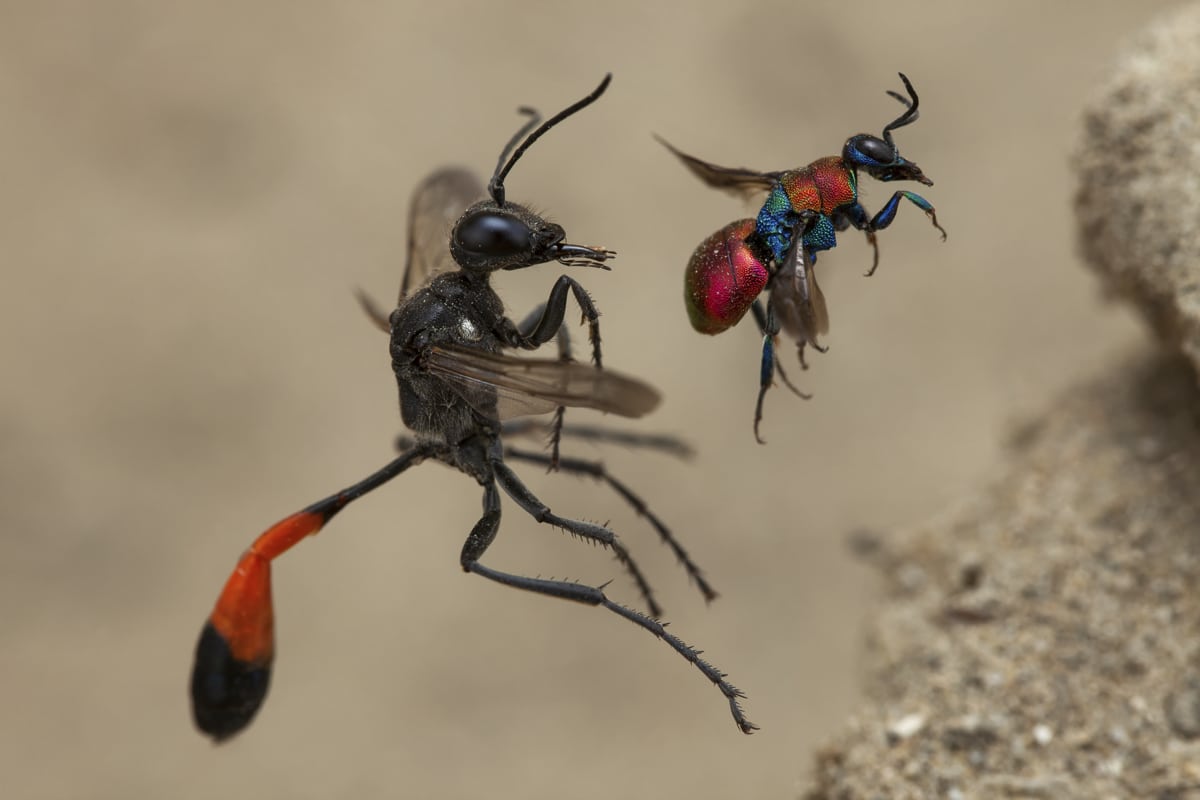
“A tale of two wasps” by Frank Deschandol, (France). Winner, Behavior: Invertebrates.
“This remarkable simultaneous framing of a red-banded sand wasp (left) and a cuckoo wasp, about to enter next-door nest holes, is the result of painstaking preparation. The female Hedychrum cuckoo wasp – just 6 millimeters long (less than 1/4 inch) – parasitizes the nests of certain solitary digger wasps, laying her eggs in her hosts’ burrows so that her larvae can feast on their eggs or larvae, and then the food stores. The much larger red-banded sand wasp lays her eggs in her own burrow, which she provisions with caterpillars, one for each of her young to eat when they emerge. Frank’s original aim was to photograph the vibrant cuckoo wasp, its colors created by the refraction of light from its cuticle (tough enough to withstand the attack of the wasps it parasitizes). In a sandy bank on a brownfield site near his home in Normandy, northern France, he located tiny digger wasp burrows suitable for a cuckoo wasp to use and out of full sun, which would have let too much light into the camera. He then set up an infrared beam that, when broken by a wasp, would trigger the superfast shutter system he had built using an old hard drive and positioned in front of the lens (the camera’s own shutter would have been too slow). Despite the extremely narrow depth of field and tiny subjects, he captured not only the cuckoo wasp but also the sand wasp. Though these two species don’t regularly interact, Frank was gifted a perfectly balanced composition by the insects’ fortuitous flight paths to their nest holes.”

“The golden moment” by Songda Cai (China). Winner, Under Water.
“A tiny diamondback squid paralarva flits below in the blackness, stops hunting for an instant when caught in the light beam, gilds itself in shimmering gold and then moves gracefully out of the light. The beam was Songda’s, on a night‑dive over deep water, far off the coast of Anilao, in the Philippines. He never knows what he might encounter in this dark, silent world. All sorts of larvae and other tiny animals – zooplankton – migrate up from the depths under cover of night to feed on surface-dwelling phytoplankton, and after them come other predators. Diamondback squid are widespread in tropical and subtropical oceans, preying on fish, other squid, and crustaceans near the surface. In November, hundreds gather off Anilao to spawn. A paralarva is the stage between hatchling and subadult, already recognizable as a squid, here 6–7 centimeters long (21/2 inches). Transparent in all stages, a diamondback squid swims slowly, propelled by undulations of its triangular fins (the origin of their name), but by contracting its powerful mantles, it can spurt away from danger. Chromatophores (organs just below the skin) contain elastic sacs of pigment that stretch rapidly into discs of color when the muscles around them contract; recent research suggests that they may also reflect light. Deeper in the skin, iridophores reflect and scatter light, adding an iridescent sheen. From above, Songda captured the fleeting moment when, hovering in perfect symmetry, the diamondback paralarva turned to gold.”

“Etna's river of fire” by Luciano Gaudenzio (Italy). Winner, Earth's Environments.
“From a great gash on the southern flank of Mount Etna, lava flows within a huge lava tunnel, re-emerging further down the slope as an incandescent red river, veiled in volcanic gases. To witness the scene, Luciano and his colleagues had trekked for several hours up the north side of the volcano, through stinking steam and over ash-covered chaotic rocky masses – the residues of past eruptions. A wall of heat marked the limit of their approach. Luciano describes the show that lay before him as hypnotic, the vent resembling ‘an open wound on the rough and wrinkled skin of a huge dinosaur’. It was 2017, and he had been on the nearby island of Stromboli to photograph eruptions there when he heard news of the new vent on what is Europe’s largest volcano. He took the very next ferry, hoping he would arrive in time to see the peak of the latest show. Mount Etna, which lies on the boundary between the African and Eurasian continental plates, has been erupting continuously for almost 30 years, with shows that include lava flows and lava fountains – just the most recent phase in 15,000 years of volcanic activity, but a warning of its power. What Luciano most wanted to capture was the drama of the lava river flowing into the horizon. The only way to do that was to wait until just after sunset – ‘the blue hour’ – when contrasting shadows would cover the side of the volcano and, with a long exposure, he could set the incandescent flow against the blue gaseous mist to capture ‘the perfect moment’.”
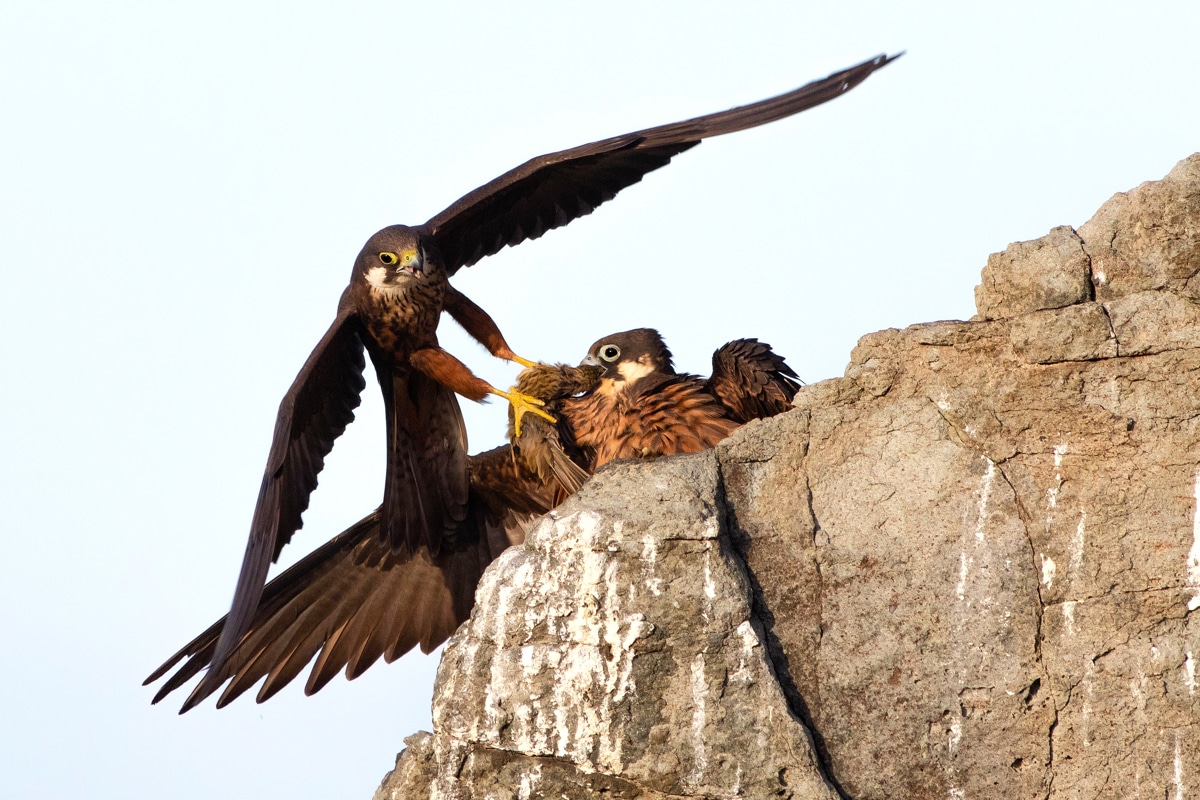
“Eleonora's gift” by Alberto Fantoni (Italy). Winner, Rising Star Portfolio.
“On the steep cliffs of a Sardinian island, a male Eleonora’s falcon brings his mate food – a small migrant, probably a lark, snatched from the sky as it flew over the Mediterranean. These falcons – medium-sized hawks – choose to breed on cliffs and small islands along the Mediterranean coast in late summer, specifically to coincide with the mass autumn migration of small birds as they cross the sea on their way to Africa. The males hunt at high altitudes, often far offshore, and take a wide range of small migrants on the wing, including various warblers, shrikes, nightingales, and swifts. Outside the breeding season, and on windless days when passing migrants are scarce, they feed on large insects. When the chicks are fledged, they all head south to overwinter in Africa, mainly on Madagascar. Alberto was watching from a hide on San Pietro Island, from where he could photograph the adults on their cliff-top perch. He couldn’t see the nest, which was a little way down the cliff in a crevice in the rocks, but he could watch the male (much smaller and with yellow around his nostrils) pass on his prey, observing that he always seemed reluctant to give up his catch without a struggle.”

“Great crested sunrise” by Jose Luis Ruiz Jiménez (Spain). Winner, Behavior: Birds.
“After several hours up to his chest in water in a lagoon near Brozas, in the west of Spain, Jose Luis captured this intimate moment of a great crested grebe family. His camera floated on a U-shaped platform beneath the small camouflaged tent that also hid his head. The grebes are at their most elegant in the breeding season – ornate plumage, crests on their heads, neck feathers that they can fan into ruffs, striking red eyes, and pink-tinged bills. They build a nest of aquatic plant material, often among reeds at the edge of shallow water. To avoid predators, their chicks leave the nest within a few hours of hatching, hitching a snug ride on a parent’s back. Here the backlings will live for the next two to three weeks, being fed as fast as their parents can manage. Even when a youngster has grown enough to be able to swim properly, it will still be fed, for many more weeks, until it fledges. This morning, the parent on breakfast duty – after chasing fish and invertebrates underwater – emerged with damp feathers and a tasty meal, just when not a breath of wind rippled the water and the stripy-headed chick stretched out of its sanctuary, open‑beaked, to claim the fish. In soft light and muted reflections, Jose Luis was able to reveal the fine detail of these graceful birds and their attentive parental care.”
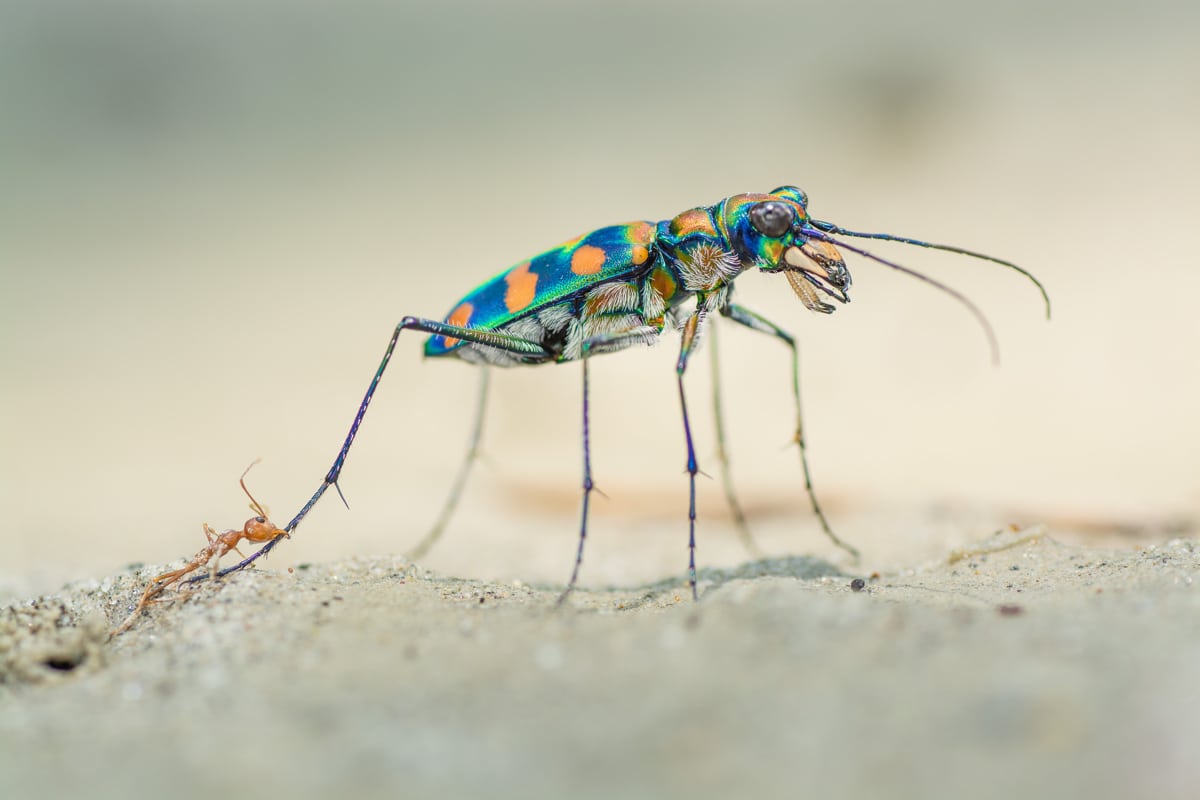
“The last bite” by Ripan Biswas (India). Winner, Wildlife Photographer of the Year Portfolio Award.
“These two ferocious predators don’t often meet. The giant riverine tiger beetle pursues prey on the ground, while weaver ants stay mostly in the trees – but if they do meet, both need to be wary. When an ant colony went hunting small insects on a dry river bed in Buxa Tiger Reserve, West Bengal, India, a tiger beetle began to pick off some of the ants. In the heat of the midday sun, Ripan lay on the sand and edged closer. The beetle’s bulging eyes excel at spotting invertebrate prey, which it sprints towards so fast that it has to hold its antennae out in front to avoid obstacles. Its bright orange spots – structural color produced by multiple transparent reflecting layers – may be a warning to predators that it uses poison (cyanide) for protection. At more than 12 millimeters long (half an inch), it dwarfed the weaver ants. In defense, one bit into the beetle’s slender hind leg. The beetle swiftly turned and, with its large, curved mandibles, snipped the ant in two, but the ant’s head and upper body remained firmly attached. ‘The beetle kept pulling at the ant’s leg,’ says Ripan, ‘trying to rid itself of the ant’s grip, but it couldn’t quite reach its head.’ He used flash to illuminate the lower part of the beetle, balancing this against the harsh sunlight, as he got his dramatic, eye-level shot.”
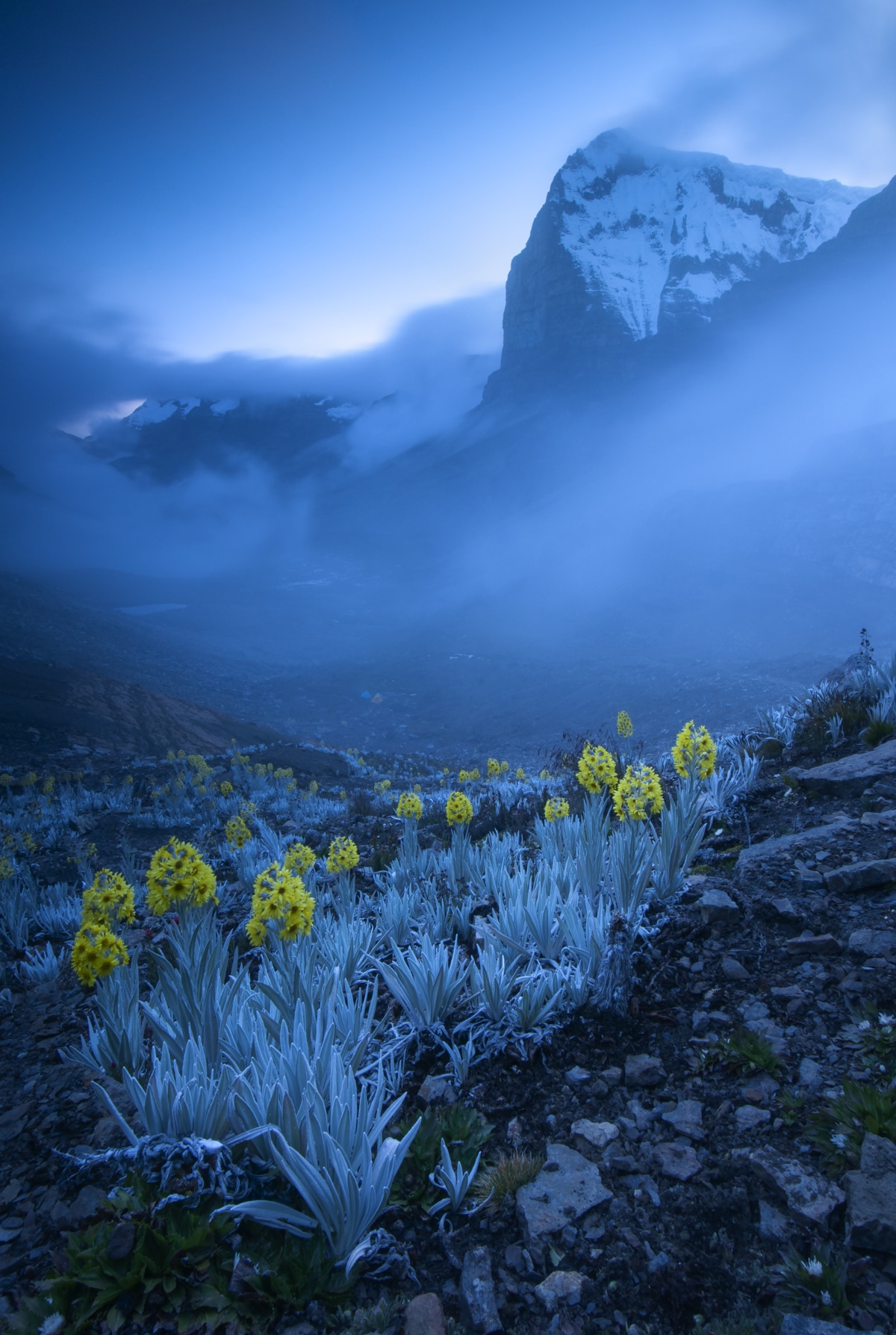
“Out of the blue” by Gabriel Eisenband, (Colombia). Winner, Plants, and Fungi.
“It was Ritak’Uwa Blanco, the highest peak in the Eastern Cordillera of the Colombian Andes, that Gabriel had set out to photograph. Pitching his tent in the valley, he climbed up to photograph the snow-capped peak against the sunset. But it was the foreground of flowers that captured his attention. Sometimes known as white arnica, the plant is a member of the daisy family found only in Colombia. It flourishes in the high-altitude, herb-rich páramo habitat of the Andes, adapted to the extreme cold with a dense covering of woolly white ‘hair’ and ‘antifreeze’ proteins in its leaves. As the magic hour of sunset passed, there followed a blue hour that drenched the scene in an ethereal blue light. But while the silver-grey leaves were washed in blue, the flowers shone bright yellow. It was also strangely calm, enabling Gabriel to use a long exposure to capture the clouds flowing over the high peak without any blur of movement among the plants. Seeming to glow ever brighter as the light faded, the yellow blooms began to dominate the scene, leading the eye towards the mountain but stealing the limelight from it.”

“Watching you watching them” by Alex Badyaev, (Russia/USA). Winner, Urban Wildlife.
“What a treat for a biologist: the species you want to study chooses to nest right outside your window. The Cordilleran flycatcher is declining across western North America as the changing climate causes shrinkage of the riparian habitats (river and other freshwater corridors) along its migratory routes and on its wintering grounds in Mexico. It also happens to be very specific in its choice of nest site. In Montana’s Rocky Mountain Front, it typically nests in crevices and on canyon shelves. But one pair picked this remote research cabin instead, perhaps to avoid predation. The nest was built on the head of a window frame by the female. She made it out of moss, grass, and other plant material and lined it with finer fibers, hair, and feathers. Both parents were feeding the nestlings, flying out to snatch insects in mid-air or hovering to pick them off leaves. So as not to disturb the birds, or attract predators to the nest, Alex hid his camera behind a large piece of bark on an ancient spruce tree leaning against the cabin. He directed a flash towards the trunk (so the scene would be illuminated by reflection) and operated the set-up remotely from the cabin. He captured his shot as the female paused to check on her four nestlings (at 12 days old, they will probably fledge in a few days). Behind her – the cabin serving as a conveniently spacious hide – the biologist recorded his observations.”

“Show Business” by Kirsten Luce (USA). Winner, Wildlife Photojournalism: Single Image.
“One hand raised signaling the bear to stand, the other holding a rod, the trainer directs the ice-rink show. A wire muzzle stops the polar bear from biting back, and blue safety netting surrounds the circus ring. It’s a shocking sight – not because of the massive predator towering over the petite woman in her ice-skating outfit but because of the uneven power dynamic expressed by the posture of the bear and the knowledge that it is not performing by choice. But for the visitors to the traveling Russian circus – here in the city of Kazan, Tatarstan – it is entertainment. They are ignorant of how the polar bear has been trained and what it might endure behind the scenes – including the fact that, when not performing, it probably spends most of its time in a transportation cage. The polar bear is one of four females, reportedly captured in Russia’s Franz Josef Land when two years old (‘abandoned’, according to the trainer) and still performing 18 years later – valuable property for the Circus on Ice, the only circus known to own polar bears. For the photographer, who has spent a couple of years reporting on animal exploitation and abuse, this was the most symbolically shocking of all the scenes of exploitation she has shot, featuring as it does such an Arctic icon of wildness.”











































































